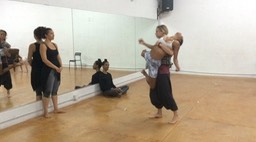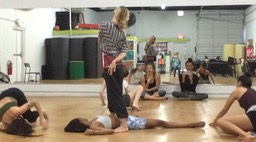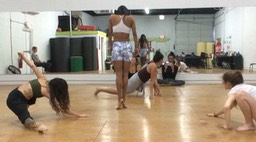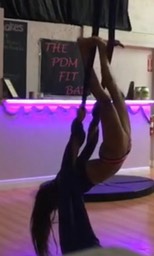CASK - Alma Dance Theater from Fishman George on Vimeo .
Reflecting on the brutal treatment she receives at the hands of Juliana Triviño, who plays her torturer in the October 28 Alma Dance Theater (ADT) production of “Cask”, fellow principal dancer Sasha Caicedo said, “Juliana is my very best friend. It's so hard knowing that I love her so much, and we have to act the opposite. The easy part is how comfortable we are.” That “comfort” makes it possible for her to accept being pushed, swung, thrown and dragged around the stage in choreographer Marissa Alma Nick’s deeply disturbing interpretation of Edgar Allen Poe’s, “The Cask of Amontillado.”
In 2007, during Nick’s senior year at the University of South Florida, “while exploring her dark side,” she became captivated by Poe’s grim short story. Its macabre narrative of rage and revenge became the vehicle for her college thesis project and also complemented her study of Carl Jung’s theory of the shadow persona – the duality of good and evil in the human psyche.
“Cask’s” themes of betrayal and revenge were personally familiar from abusive love relationships Nick had endured. “We’ve all felt pain; we’ve all felt hurt by someone we loved,” she reflected in a recent interview. In Poe’s story, set in an unnamed European city, centuries ago, nobleman Montresor (Triviño) had been grievously affronted by his fellow wine connoisseur, Fortunato (Caicedo). The unspecified offense drove Montresor so mad that he determined to secretly murder Fortunato after luring him into his wine cellar – purportedly to sample a cask of rare Amontillado sherry.
For this Halloween evening performance, the audience will encircle the performers in a simulation of the original catacomb-like cellar into which Montresor lured and murdered his victim, although the wide-ranging movements of the two principals and three corps dancers demand a larger stage than the claustrophobic setting of the original. Also new is the use of aerial silks, a type of acrobatics, executed while hanging from long strips of fabric, secured to overhead rigging.
Practicing and performing with the silks demands prodigious strength and flexibility. They serve as a versatile and expressive vehicle of potential escape and of bondage for Caicedo’s ironically named Fortunato character. Her slender physique, minimally costumed, clearly reveals the punishment meted upon her by the malevolent, but inwardly tortured Montresor (Triviño), whose regal gown reinforces her dominance, pride and vanity in what may be a sadomasochistic relationship.
Montresor, while holding the figurative whip handle, also suffers immensely. His (her) insane anguish is first revealed in the contortions of her initial solo and amplified by the recurring appearance of three dancers, “Tenebris” (darknesses) who embody and externalize multiple facets of her inner life. These new members to the “tribe” of ADT, contribute complexity, patterning and dramatic interaction with the principals – forming knots, swooping, writhing, mirroring and contrasting with one another. In a key sequence, they move to center stage on hands and knees, like one multi-jointed creature.
Inspiring a strong esprit de corps among the company’s members is central to Nick’s coaching. “We are comfortable enough to take it up a notch beyond just partnering with each other and trusting each other enough to [let them] throw you around or slap you,” added Caicedo.
Nick melds the cool video aesthetics of Screendance video with the immediacy of theater-in-the-round and Japanese Butoh theater to her experimental practice. This strategy pushes audiences to focus not only on the “big picture,” but to zoom in on the nuances of skin texture, subtle flexing of joints, angles of limbs.
Music is integrated in a distinctive fashion. Composer Hope Littwin, who attended Miami’s New World School of the Arts with Nick, remains a favorite collaborator. After initial conversations and exchanges of musical samples, Nick left Littwin to her own process and used Philip Glass’ minimalist “Koyaanisqatsi” movie score during rehearsals. As the choreography takes shape, Nick sent Littwin rehearsal videos to help her grasp the dramatic flow, transitions and timing, although the movement is not determined by the music, as in most choreography. In fact, Littwin’s music won’t arrive until the final week, intentionally keeping things fresh and vital for the dancers now entering their final week of rehearsal before the Halloween performance.
Choreographer/ Director: Marissa Alma Nick
Musical Composer: Hope Littwin
Stage / Costume Design: Marissa Alma Nick
Lighting Design: Gary Lund
Aerial Silks Tech: Keisha Whitfield
Montresor: Juliana Triviño
Fortunato: Sasha Caicedo
Tenebris dancers: Faye Tori Akin, Alessandra Ochoa, Marisa Turner



